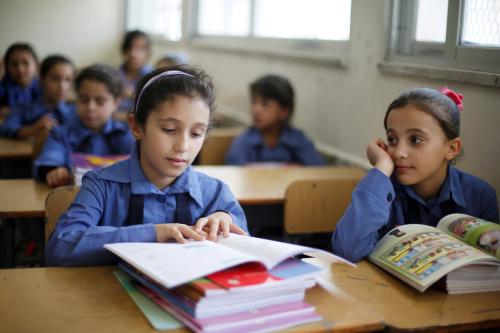Last week, the Center for Universal Education (CUE) at Brookings hosted its annual Girls’ Education Research Symposium, featuring the 2016 Echidna Global Scholars. The scholars offered three key approaches to the theme of developing life skills for girls globally: empowerment programming, tapping into teachers’ potential to mentor girls, and building resilience to the effects of climate crises. In addition to experts, champions—including Tina Tchen, First Lady Michelle Obama’s chief of staff and executive director of the Council on Women and Girls, and the Honorable Joyce Banda, the first female president of Malawi and visiting fellow at the Wilson Center and the Center for Global Development—convened to discuss evidence-based solutions for girls and pathways forward for the field of girls’ education.
Here’s what we learned:
- Consider the girl from birth to adulthood
When addressing barriers to girls’ education, programs and policies have targeted the unique obstacles faced by adolescent girls. While an important entry point, Joyce Banda’s current work cautions the girls’ education community against stepping in too late, recommending instead interventions for ages 0-10 in order to get ahead of the challenges that most girls will face once they reach adolescence. Tina Tchen continued this line of thought, reminding the audience that “adolescent girls become women” and will go on to be the leaders in society and determine our collective future. So as we design interventions and assess their outcomes, we must think across the lifespan of the girl, bridging the work that focuses on early childhood, on adolescent girls, and on women.
- Engage the community
Girls do not exist apart from their communities; thought-leaders and practitioners alike must be mindful of this when operating from an empowerment approach. In the opening panel, Judith-Ann Walker, from the development Resource and Project Center in Nigeria, reminded everyone that “empowerment” shouldn’t “just be a word.” Her organization has worked to ensure that communities are a part of the solution, not just a talking point. They’ve done so by training civil servants and policymakers in gender sensitization and including men in girls’ education work.
Another point was made from the audience about the importance of a “do-no-harm” approach to girls’ empowerment programming, recognizing the safety challenges that are often a byproduct of strengthening girls’ voices and building their self-esteem and communication skills, for example. Urvashi Sahni, from the Study Hall Education Foundation in India, explained that in their work it is crucial to create a “safety net so that the empowerment does not stop” when girls are in harm’s way.
- Support teachers and young mentors to develop girls’ skills
Teachers perform tasks far beyond what is on paper in their job descriptions. Female teachers who serve as mentors and role models to girls are particularly vulnerable to being undervalued and overworked. A panel on “uncovering teachers’ potential to improve girls’ learning outcomes through mentoring” discussed the need for female role models in girls’ education, but found that the feminization of teaching often means a “degradation of the profession.” Governments must support and elevate female teachers in order to protect against the gendering and devaluation of the profession more broadly. Further, while young mentors do not face the same institutional challenges as teachers, accreditation processes such as Camfed’s learner guides’ internationally recognized certifications help to support their roles as young mentors and provide new opportunities for their own continued skills development.
- Cross-sectoral engagement is key to holistic action for girls
The final panel of the day, “Fostering resilience for climate change adaptation through girls’ education,” brought together actors from, in, and beyond the girls’ education community, demonstrating the need to work across sectors to address girls’ education challenges as they arise within a broader education ecosystem. The Sustainable Development Goals are inextricably linked and interdependent. However, sectoral specialization often leads experts to deepen their work without reaching outwards. Panelists noted that while engaging girls’ local communities is key, the crux of increasing impact for girls lies in cross-sectoral collaboration. Girls’ education challenges are not confined to the classroom or to the walk to school, but can also emerge from household economic strains caused by climate crises—challenges that inevitably involve sectors beyond education.
- Persisting questions
Participants agreed that one of the key takeaways were the persisting questions that continue to surface around girls’ life skills education. Among these were:
Can all skills be taught?— A cursory remark was made by the Hon. Joyce Banda about whether leaders are born or made, bringing attention later in the day to a broader question around whether skills like leadership, communication, and risk perception can be taught.
If skills can be taught, how can girls transfer skills from safe spaces to the outside world?—Tied to the “do-no-harm” approach, programs can often achieve success in safe spaces such as girls’ clubs. But do those skills remain when girls move from girl-only or girl-friendly spaces to the home or to the school?
What about the boys?—The girls’ education community is, after all, concerned with the right to a quality education for all children. Participants were eager to continue the dialogue and brainstorm ways to engage with practitioners and policymakers in a way that doesn’t forget about the boys.
The Brookings Institution is committed to quality, independence, and impact.
We are supported by a diverse array of funders. In line with our values and policies, each Brookings publication represents the sole views of its author(s).








Commentary
Developing life skills for girls: 5 takeaways from the 2016 Girls’ Education Research Symposium
December 21, 2016